If you're insanely lucky, you'll have a stud in your wall exactly where you want to hang something heavy. For the other 99% of the time, you're going to need to use a drywall anchor to hang that thing on the wall. (That's a sheetrock anchor for the American folks out there.)
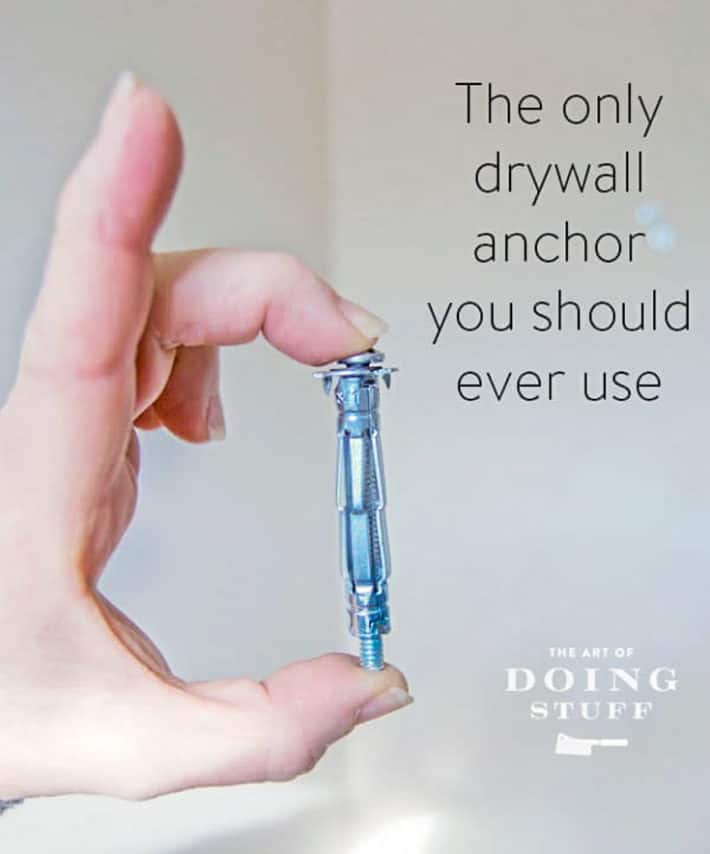
I know. The drywall anchor! It's a big, scary looking thing but once I explain it, it'll be about as scary as a chocolate covered cotton ball. I'll be calling it a drywall anchor through this post by the way because that's what it's called in my area in Canada. You might refer to it as sheetrock and a sheetrock anchor, but it's the same thing.
We've all been there I'm sure ... hung a full sized cow on our wall only to have it fall down in the middle of the night, scaring the farts right out of the cat. It happens. But it doesn't have to.
For some reason people are under the impression that hanging things on the wall is frightening. This fear stems out of two things. The fear of filling your wall with holes (you can overcome that fear in this tutorial where I teach you how to fix nail holes in drywall), and the fear of having no idea what the hell you're doing, what the hell you're supposed to use and how the hell you're supposed to use it.
Also you hung something once before and it fell down. And it was traumatizing.
But that's only because you probably used the wrong types of drywall anchors. I bet you're using those little, brightly coloured plastic wall anchors aren't you?
It's O.K. Not knowing, making mistakes, asking questions and learning are all a part of your successful home improvement journey.
Table of Contents
Plastic Wall Anchors
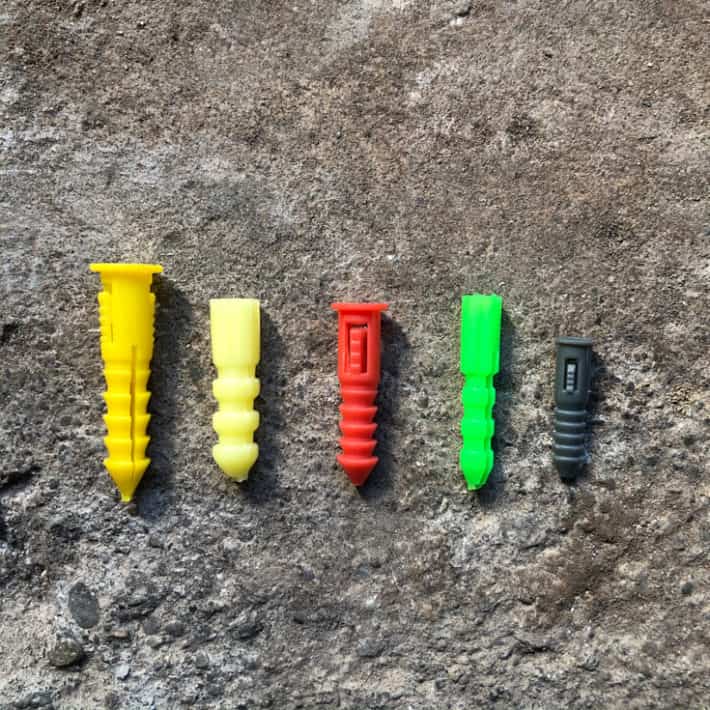
I've used them too. I'll admit it. Those plastic anchors (expansion anchors) in bright colours that you hammer into the drywall. You keep screwing and screwing your screw into it and it just keeps spinning and spinning because it isn't actually grabbing onto anything. But you hang something off of it anyways because you paid for it and installed it and can't think of any other way to do it. Then your cow falls down.
It's because those plastic anchors aren't really meant for drywall. They're actually meant for solid walls like concrete. They *can* in certain circumstances be used for drywall but even the must robust plastic anchor can only hold around 10 pounds. So they're very definitely light duty and don't have a lot of holding power.
If you INSIST on using a plastic wall anchor in drywall, remember this tip.
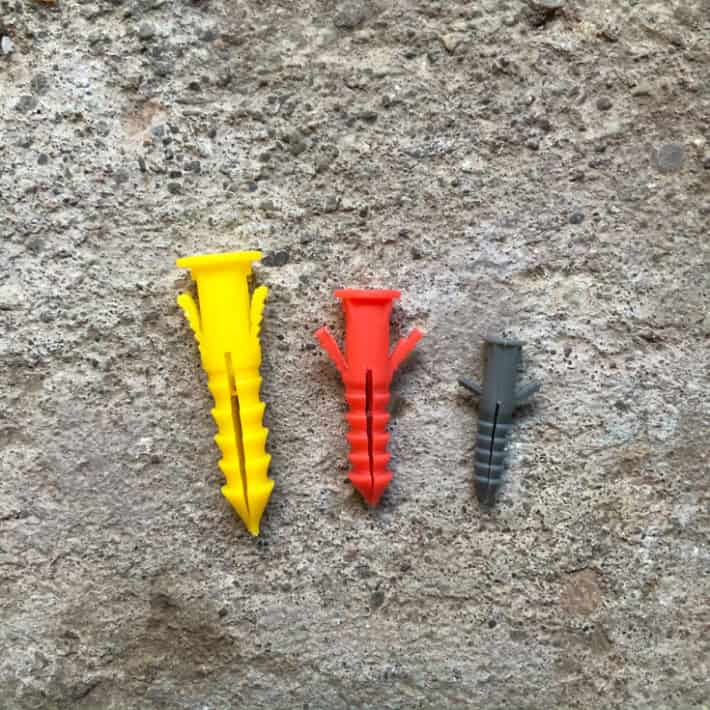
Pull the wings out on your plastic anchor!Not all plastic anchors are going to have them, but if they do, pull them out. They'll squish back in when you hammer the anchor into the wall but they'll pop out again a bit once they're in there. They'll help (a minuscule amount) to keep the anchor from falling out of the wall.
So if plastic wall anchors are crap, what should you be using to hang your stuff on the wall?
Threaded Anchors
Threaded anchors, (also called self-drilling anchors and E-Z anchors) are the absolute easiest choice and one of the most effective. They have a point on the end so you can tap them into the drywall. Then just stick a screwdriver into them and screw them in the wall. An average sized threaded anchor can hold about 50 pounds.
But my favourite is the hollow wall anchor. Otherwise known as a Molly Bolt. It's more complicated to use than the threaded anchor but I like them better.
What is a Molly wall anchor?
Also known as the classic "Molly Bolt" or a molly wall anchor. THESE are the only drywall (sheetrock) anchors you should use. (bit of an exaggeration but honestly if you aren't sure what to go with they are the best.) How do I know they're the best? Just ask Bessie the cow.
These are my favourite anchors. Yes there are others like screw-in anchors, toggle bolts and a bunch of other things, but these Molly wall anchors are my favourites so that's why I'm talking about them and telling you to use them too.
When you buy a box of Hollow Wall Anchors there are 3 things you need to look for on the box:
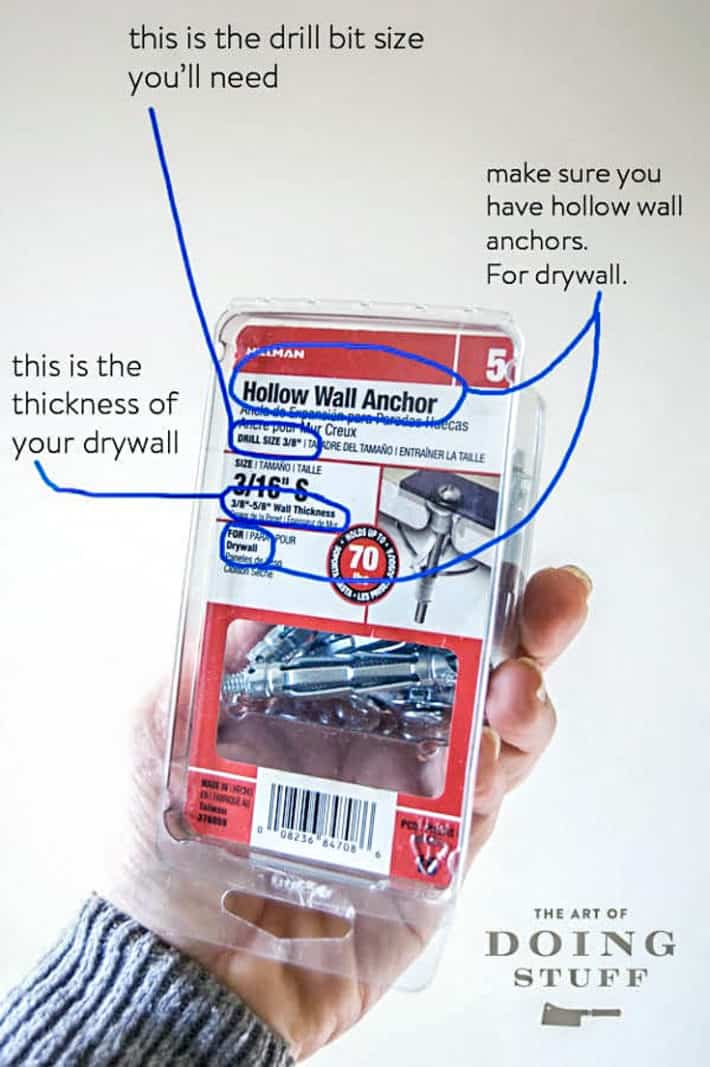
What to look for in Hollow Wall Anchors
- Make sure what you're buying is indeed a Hollow Wall Anchor for drywall.
- Make sure they're the right size for your drywall. This box is good for drywall that is ⅜ths to ⅝ths thickness. (there are other Hollow Wall Anchors that are for very thin materials like hollow doors)
- Note the size of the drill bit that they recommend you use and make sure you own one!
Also make sure you own a drill. I have a couple of drills, a "vintage" electric one I found at a garage sale that's GREAT and this Ryobi cordless one, which is great when the battery actually works. If you have issues with 18V batteries suddenly not charging, read my post on how to get a seemingly dead cordless battery to take a charge.
How to use Molly Bolts To Hang Stuff on Drywall
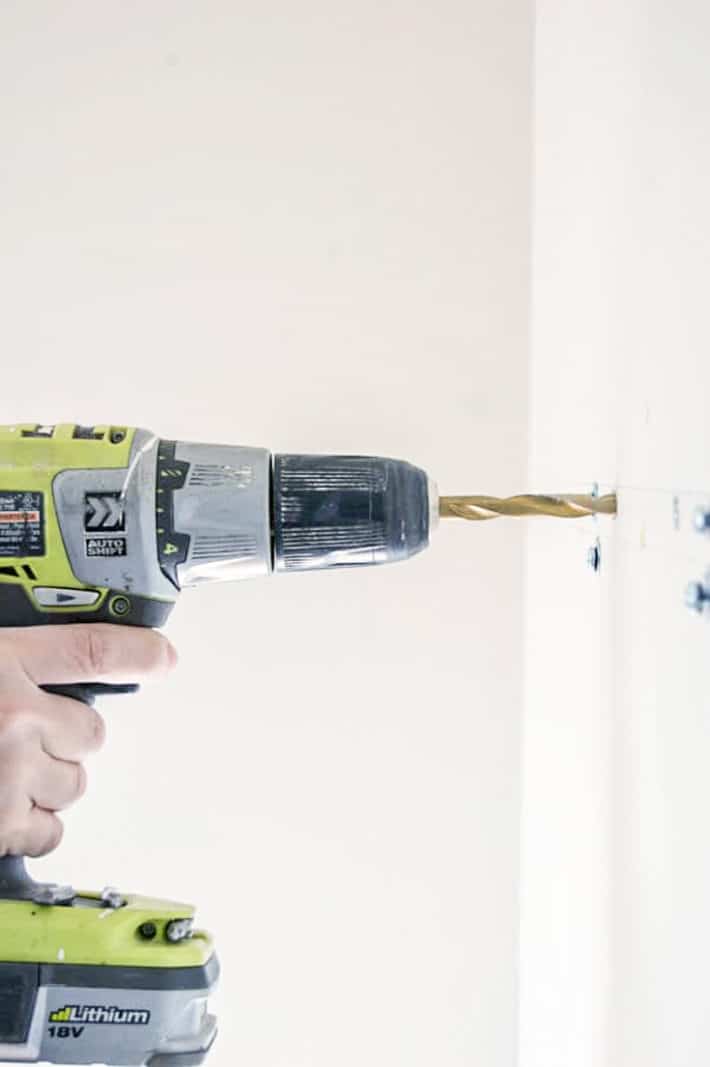
- Mark the place on your wall where you want to hang something. Using the right sized drill bit, drill your hole. DON'T go wiggling all over the place with your drill. Hold it stead and drill straight in and pull straight out. If you wiggle you'll actually drill a larger hole.
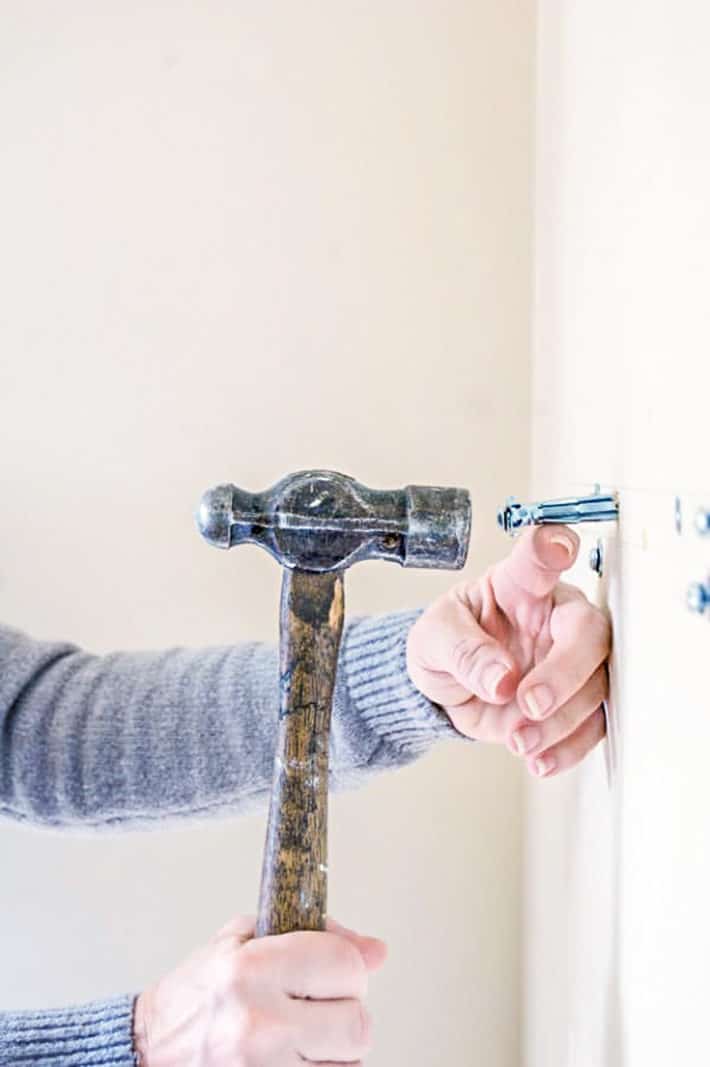
Would you like to save this stuff?
2. Take the Hollow Wall Anchor out of the package and hammer it straight into the wall. You don't have to adjust it or fiddle with it or anything. Just whack it in there.
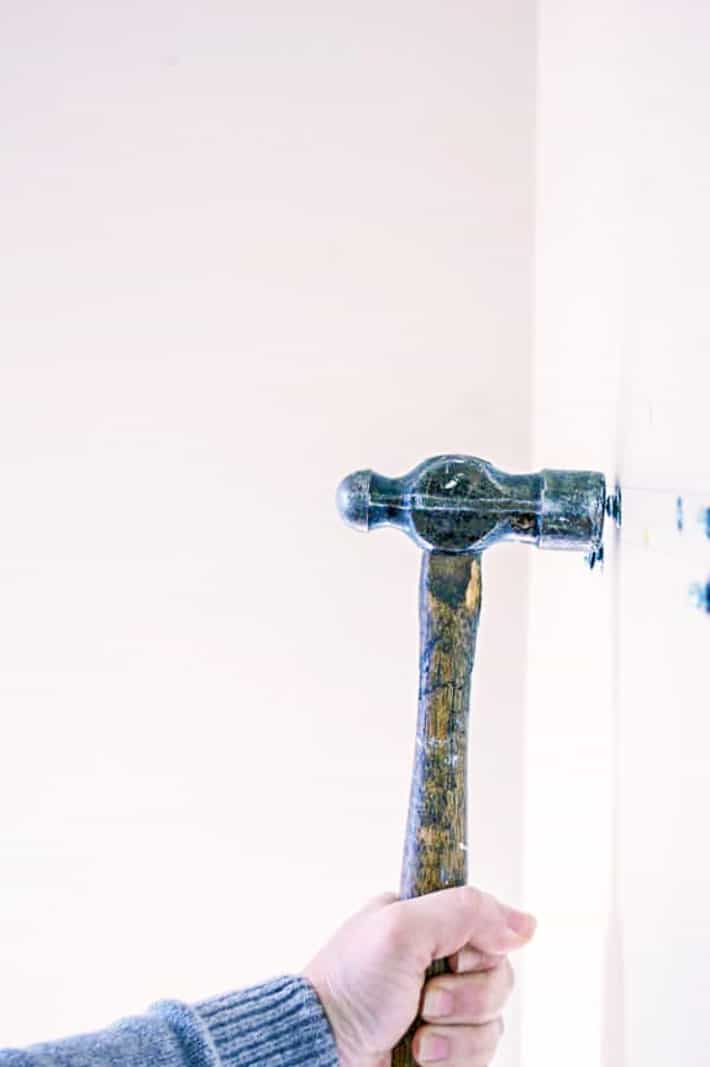
If you look back up at the first picture I showed you you'll see that there's tiny teeth under the flat edge of the anchor. These will grip into the outside of the drywall so make sure you hammer it in good.

3. Now you get your screwdriver and start screwing the screw in. I know it looks like it's already in (and it is) but what you're doing at this moment is creating Hollow Wall Anchor magic.

As you screw the screw in, a sort of flange is being pushed out at the back of the drywall. The more you turn the screw the tighter and tighter the flange gets. Just keep turning until you can feel some good resistance. It may take a while and you might get bored.

4. Once you've screwed it in to the point that you feel the resistance of the flange (I'm not really sure that's the right word to be using) against the back of the drywall you can start unscrewing the screw. Again. Totally boring.
I recommend doing it by hand though and not with a drill because you don't have enough control over the drill and if you screw your Hollow Wall Anchor in too tightly you could end up squishing your drywall and ruining it. Just do it by hand. Super exercise for your wrist anyway which will come in handy the next time you slap someone.
- If you're only hanging a mirror or picture then you can just pull the screw out enough to get your wire picture hanger over it.

- If you're attaching something to the wall like a bar or TV mount you might have to remove the screw entirely and then, yes, screw it back in again.
And don't worry. Undoing the screw doesn't do anything to the flange. It stays rock solid. That baby's in your wall for good now.
Seriously. To remove a hollow wall anchor you have to just hammer it into the wall and fill the hole it leaves with drywall compound. Yes. I know. That's scared you even more. Calm down. Remember? I showed you how to fix a hole in drywall. It's easy.

What are the Strongest Drywall Anchors?
If you use either the threaded anchor or the molly bolt you'll do just fine. They can easily hold 50 pounds.
If you want to hang something a very large, heavy picture or mirror these no stud picture hangers are the absolute BEST. They are hooks and specifically for hanging mirrors or heavy artwork and I've used 2 of them to hang the life sized portrait you see in this post. Each of these hooks will support 200 pounds.
You're still scared. You don't think you can do this. It seems ... scary and you're pretty sure you're never going to need to hang anything on your walls. Ever.
You say that now, but one day you'll be driving around the countryside, hit a cow by accident and need to hang it. Now you know how to do it and what to use.
Good job.
→Follow me on Instagram where I often make a fool of myself←
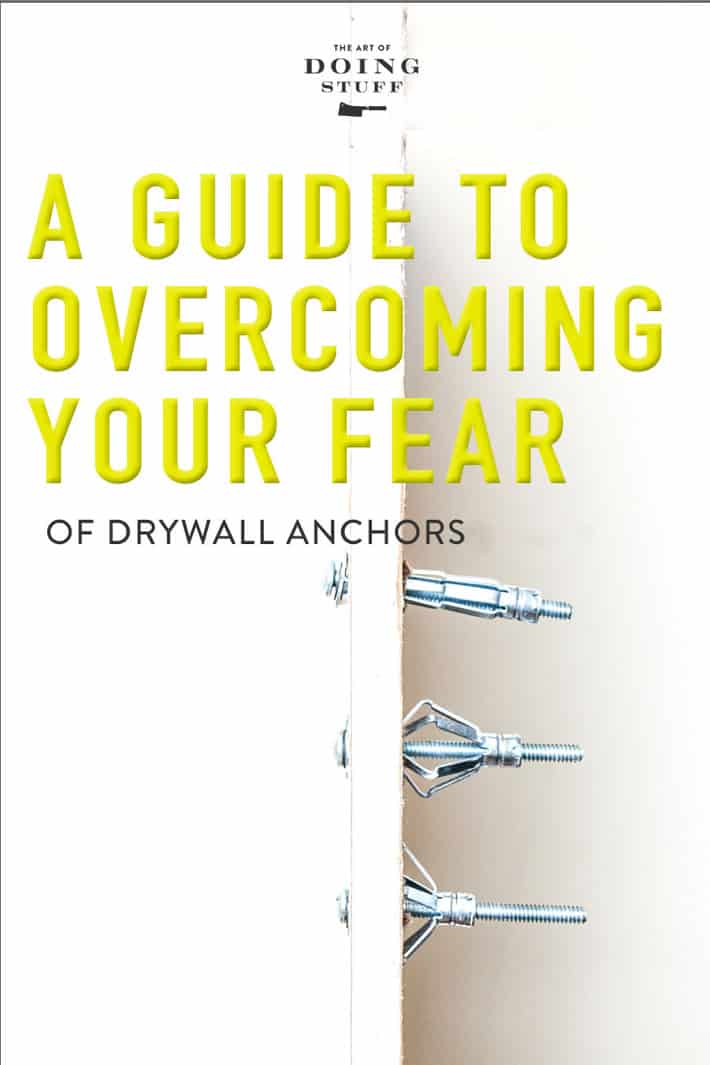






CT
Hi, how would I know the thickness of the drywall? We rent and while I'm proficient about hanging shelves and stuff I often find I've changed my mind and want to rearrange things years later (plus we have the joy of orange peel walls to really making patching a hole a task). I'd like to hang a shelf but am in two minds as to which depth I go with so am debating using Molly bolts so I can fix one shelf and if it's too deep I can replace it with the narrow version. I just have no clue how I'd find out what the drywall depth is.
Derek
If you own an electric drill, there's a simpler way to remove a molly anchor and avoid a large repair. Remove the screw from the anchor. Take a steel drill bit that is just larger than the outside diameter of the shank of the anchor. Drill into the screw hole until the anchor face is cut from the shank. Then push the remaining shank into the cavity behind the drywall where it drops out of sight. Now you have only the original drilled hole to repair.
Sydney Allrud
Question about Molly bolts. Not knowing what I was doing, I pulled out a loose Molly bolt and filled the hole with plaster patch. Now it looks like I need to put a replacement bolt in the exact same place. Is it ok to install a new Molly bolt right in the patch? Would a toggle or some other bolt work better? I'm just hanging a toilet paper holder, not a cow.
Stefanie
Hi! Love this post. Would this be appropriate for hanging curtain rods too or does that require something different? Thanks!
L B
Question we have brick behind the plate real, and maybe a thin wood layer in between. Will a molly bolt expand inside the wall if it’s not hollow???? I need help trying to hang a tv above fire place but we running into brick!
David E Pinkston
If the real is less than 1", Use Tapcon blue screws. May need to predrill with masonry drill half the thickness of the screw, but these screws are designed to bight right into cinderblock, and are available at most home improvement stores.
Regina S.
Hi,
Appreciate your information on the Molly Bolts and the No Stud Picture hangers.
I like the No Stud ones but not sure I want to create a 1/4" whole in the wall.
What do you think of the OOAK nail in hooks that support 100lbs for 1/2" drywall with hollow back?
Thank you in advance.
Karen
They're great. ~ karen!
KnowItAll
There is actually a proper tool to install Molly bolts, and its a whole lot easier and faster than using a screwdriver. It's called a "Wall Anchor Setting Tool". Do a quick Google search for images and videos for what it looks like and how it's used. After you do, you'll never want to use a screwdriver to install a Molly bolt again.
Paula Marshall
"Drywall." And to us Americans, it's Sheetrock.
We don't all make the dumb mistake of calling an object by one of its brand names.
I don't call it Sheetrock, I call it drywall.
I don't call it a Kleenex, I call it a tissue.
I don't call it a Xerox, I call it a copy.
Michael Taylor
It's not dumb at all to call a generic item by a brand name. When that brand name is adopted by nearly everyone, it's called "normal".
Is it precise? No, but who really cares? You know exactly what someone is talking about when they use a brand name for a generic item.
Molly A. Badgett
You are mean.
Jules Peterson
Ok, so I got over being scared and did everything exactly as described. The first candle holder went up with no issues, but the second one didn't. The screw won't come back out of the wall! It just keeps spinning in the same position. I have no clue why, but my husband is not a happy camper and I'm not sure how to solve the issue. Suffice it to say, now I'm really scared.
Karen
Hi Jules. It's hard to say what happened without seeing it but if it's spinning, try holding the screw with your fingers and pulling it towards you. This will pull the butterfly on the inside of the wall towards the drywall and it will stick there. Once you feel the pressure that the butterfly is against the wall, then with your fingers start screwing in the screw again. ~ karen!
Isabella Angelini
I'm trying to hang a heavy duty screw-in utility hanger into drywall with no stud. Obviously I need some sort of anchor, but the screw diameter is about 1/2 inch and way to big for any anchor I can find.
Any suggestions for a large diameter anchor?
Karen
Hi Isabella. I'd need to see a photo of what exactly you're doing but it sounds like you're maybe trying to hang a utility hook? So something that the screw is attached right to the item? If that's the case you have to drill into a stud. That's what they're made for. If it's something you can switch out the screw then you just use the one that comes with the anchor. You can also use an EZ anchor like this for something like that. https://amzn.to/3dL9zOz ~ karen
Leslie Russell
I needed this more than you know. I can hang just about anything but I am the worst curtain rod hanger in the world. I make a million holes, the rods don't stay up and I'm out of my mind. Because I've been using plastic anchors all these years...for curtains!!!
I never thought to try these and I just fixed a curtain rod that yes, had fallen down and I was ignoring it but now I'm having company and have to do something about it. The instructions on the package were *#** but I pulled up your article and voila! The only thing that threw me was that I had to screw that screw in even further and you covered that in your article! I am forever in your debt. So are my walls.
Yyz
I remember my parents using these a long time ago. Now they seem to be extremely difficult to find in the US. Amazon sells variety packs without any mention of wall thickness. I only have ONE thickness of wall in my house!
Carole
You need to check out, and do a post on, monkey hooks.
I have an 80-pound mirror hanging from two monkey hooks I was able to insert in the wall with one hand. It's been hanging for about 4 years. NO tools to get out. NO mess to clean up. NO tools to put away. If you hang something that requires two anchor points, at most you will you need a pencil and a measuring tape (and a level if you want it dead straight).
If you should change your mind and want to move whatever you've hung, the monkey hook is easily removed by hand, and is reusable. Plus you are left with a tiny hole to patch, as compared to the destruction a wall anchor causes, forcing you have to deal with the mess and all the stuff to repair the hole - patching compound, sandpaper, wall texture.
Monkey hooks take the monkey business out of a majority of one's hanging needs. Of course anchors are the only solution for some kinds of applications, but monkey hooks are just an incredible solution to the majority of my hanging needs.
PS I am in no way associated with monkey hooks! I just love them.
gerald anthony
The white plastic anchors with a point on the end are way better than what you are showing.
Hint: drill a 1/8 pilot hole before using the self drilling anchors. It allows for a more precise location of the anchor. The only word for what you are using: archaic.
Tina
I’m sorry, I must disagree. I get the metal, screw in anchors like this: https://amzn.to/2O0jQv2
They are the bees knees! They screw in easy-peasy and there’s no waffling about whether you’ve screwed the other kind enough or if they screw up your dry wall. They’re idiot proof! And they can hold serious weight. And if you accidentally hit a stud, they still work! I love them!
Brenda
I think I used those once ... it was a long time ago and I did my research and then put up an ikea thing on the drywall wall in my kitchen that I hung all my pots & pans on and seriously I can't believe it never falls down every time I put a pot back up after I use it or walk by it. It's one of the wonders of the world in my home! I am so glad you wrote about this because I would never have remembered what I did (I also hung a little shelf in my bathroom with some of these things which I don't like ... so now I know I have to bang them into the wall and I also have another bunch of holes to fill where I think I probably used one of those pretty plastic things and didn't pull wings out and there's like a whole track line of holes where I kept trying until one went in and kind of stayed ... I say it stayed - really it dangles very wiggly out of the hole and weight of the thing I hung holds it in by gravity). Good Post AGAIN!
Oksana
Amazing article! I just purchased a house and trying to learn all kind of things, particularly how to hand something on the drywall. Thank you for your explanation, it is very helpful.
Karen
Great! Thanks for letting me know. I"m happy it helped. I KNOW how confusing it can be. ~ karen!
Brent Tharp
I love your irreverent style. And the article was sweet pithiness. I was looking for the best type of drywall anchor to use for something heavy (highest-rated load-bearing capacity), and this is exactly what I needed. All the various manufacturers of these things make it difficult to know which is best.
Thanks!
Karen
Thanks Brent! There are other things I would use for really HUGE stuff but for a basic drywall anchor, this is the best bet. Hope it works out for you! ~ karen!
Paula
I cannot believe these things are so hard to find. I took down a curved shower curtain rod to do some painting. 3 out of the 4 anchors are no longer useful so I've been looking for them all over. In the picture where you explain what to look for I noticed that it is exactly what I need however on mine it shows 1/8SL when I take a magnifying glass to it. I first went to HD and they don't carry them. They gave me Drywall and Stud anchors but they do not work for this as the rod doesn't sit flush with the wall. Either that or I am weak and could not screw them in enough. I went to Hillman's website and could not find them (SL). I did a Google & Amazon search and can't seem to find them. I might be tired from the holiday weekend but it is driving me nuts. Any suggestions on where to purchasewould be appreciated?
Karen
Yikes! You wouldn't think they'd be that difficult to find! Major home improvement stores should have them but remember they might be from another brand or with another name. Maybe take a screen shot of them and show them to the people in the store? I'm not sure what else to say. :/ Sorry! ~ karen
Debbie
You might try looking at Menards. I did a search on their website for hollow wall anchors and they have several kinds and sizes. I like these better than the plastic ones for my plaster walls. So far they have held up very well.